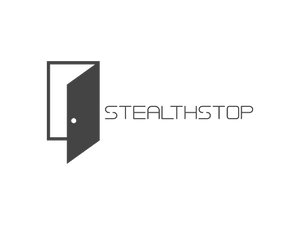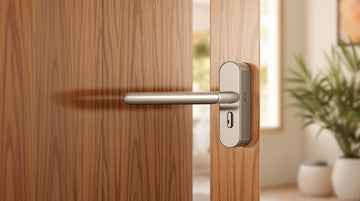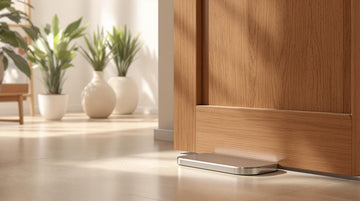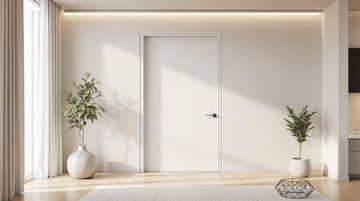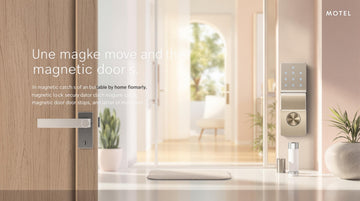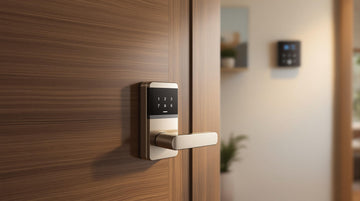
Magnetic door locks are a modern solution for enhancing smart home security. These locks use electromagnets to secure doors and can be remotely controlled via mobile apps or integrated with smart home systems. Here's what you need to know:
- What They Are: Magnetic locks (maglocks) use an electromagnet and armature plate to lock doors when powered.
-
Key Benefits:
- Remote access and control
- Easy integration with cameras, alarms, and lighting
- Strong security with minimal maintenance
-
How to Choose:
- Check holding force (600 lbs for homes, 1200 lbs for commercial)
- Ensure compatibility with your smart home platform (Z-Wave, Wi-Fi, etc.)
- Look for features like emergency release and tamper protection
-
Installation Tips:
- Requires basic tools and knowledge of voltage (12V/24V DC)
- Integrate with smart hubs for automation and alerts
For enhanced safety, pair maglocks with backup power systems and additional security layers like cameras or biometric authentication. Products like StealthStop offer sleek, durable magnetic solutions for added convenience and style in smart homes.
Access Control System with Door Lock and Card Reader Integration
Selecting a Magnetic Door Lock for Your Smart Home
Picking the right magnetic door lock for your smart home is about more than just adding security. It’s also about making sure the lock works seamlessly with your existing devices and systems. Here’s what to keep in mind.
Key Features to Look For
One of the most important factors is holding force, which determines how secure the lock is. For most residential doors, 600 pounds of holding force is enough. For commercial spaces, you might need something stronger - up to 1200 pounds. Also, check the lock's power requirements. Most models run on 12V or 24V DC, so ensure your system supports this.
Another crucial consideration is compatibility with your smart home platform. Look for features like:
- Power supply and voltage compatibility
- Holding force that matches your security needs
- Platform support (e.g., Z-Wave, Wi-Fi, or Bluetooth)
- Emergency release and tamper protection
- Ease of installation (DIY vs. professional)
Magnetic Door Lock Options to Explore
Some magnetic door locks stand out for their reliability and smart home integration. For example:
- Olide Smart's 400lb Magnetic Lock: A dependable and easy-to-use option for residential setups.
- Kisi's Maglock: Known for its ability to integrate with a wide range of smart home systems.
Both models come with features like:
- Remote control via mobile apps
- Integration with devices like security cameras and smart doorbells
- Emergency release mechanisms
- Biometric authentication capabilities
When choosing a lock, consider your door's material. Locks designed for metal doors might not work well with glass. Also, double-check that the lock is compatible with your current or planned smart home platform.
Once you've chosen the right magnetic door lock, the next step is setting it up and connecting it to your smart home system.
Guide to Installing and Setting Up Magnetic Door Locks in Smart Homes
Installation of Magnetic Door Locks
Setting up magnetic door locks requires careful attention to detail to ensure they function correctly and provide the desired level of security. You'll need basic tools like a drill and mounting hardware, as well as an understanding of the voltage requirements. Most residential magnetic locks work with either a 12V or 24V DC power supply.
Here’s a simple breakdown of the installation process:
- Mark and prepare the mounting points: Securely attach the electromagnet and armature plate in the designated locations.
- Connect the wiring: Follow the manufacturer's instructions to connect the wiring and confirm the voltage matches the lock's specifications.
"The installation guide for magnetic locks on Kisi emphasizes the importance of identifying the correct voltage (12V or 24V) and using the appropriate wiring setup" [2].
Connecting Magnetic Door Locks to Smart Home Systems
Once your lock is physically installed, the next step is to integrate it with your smart home system. This requires a compatible smart home hub, and the process can differ depending on the platform you’re using. However, the general steps include:
- Connect the lock to a controller: Configure the connection settings, such as the unlock timing, to match your preferences.
- Set up custom routines: Tailor automation features to your needs, enabling the lock to work seamlessly with other smart home devices for added convenience and security.
Here are some common features you can configure:
| Feature | Options |
|---|---|
| Access and Security Features | Biometric, PIN, RFID, Two-factor Authentication |
| Automation and Remote Access | Mobile/Web Control, Time/Event-based Controls, Geofencing |
To keep your setup secure, always update the firmware and use strong, unique passwords. Pairing the lock with other devices like security cameras can further enhance your home’s safety.
With your magnetic lock installed and integrated, you’re well on your way to a more secure and convenient smart home experience.
sbb-itb-7d66a95
Safety and Security Considerations for Smart Home Systems
Emergency Access and Fire Safety
When using magnetic door locks in your smart home, having a plan for emergency access is a must. Fail-safe configurations are key, ensuring doors automatically unlock during power outages.
Here’s a quick breakdown of essential features to include for reliable emergency access:
| Safety Feature | Purpose | Implementation |
|---|---|---|
| Fail-Safe Power Setup | Unlocks doors during power loss | Electric strike that de-powers to unlock |
| Backup Power System | Keeps locks functional during outages | Install a UPS (Uninterruptible Power Supply) |
| Emergency Override | Manual release in emergencies | Use a physical override switch or key bypass |
"Electric strikes that are fail-safe, meaning they unlock when power is lost, are essential for ensuring emergency access during power outages" [2].
These features not only protect you during power outages but also ensure quick access during emergencies. While emergency access is crucial, adding extra security measures can further safeguard your smart home.
Additional Security Measures
Pairing magnetic door locks with other smart devices creates a layered security system, boosting the overall protection of your home.
For a well-rounded system, consider integrating these security layers:
| Security Layer | Components | Benefits |
|---|---|---|
| Access Authentication | Biometric readers, PIN pads | Adds multi-factor verification |
| Surveillance Integration | Security cameras, motion sensors | Provides visual monitoring |
| Smart Alerts | Mobile notifications, alarms | Detects and reports incidents |
Keeping your system up-to-date with regular maintenance and firmware updates is essential for reliability. When choosing new devices, make sure they’re compatible with your current smart home platform. For example, if you’re using a Kisi system, ensure any new security gadgets work seamlessly with Kisi controllers [2].
For added physical security, StealthStop’s neodymium magnet offers strong door control, acting as a solid complement to your primary lock [1].
StealthStop: A Magnetic Door Solution
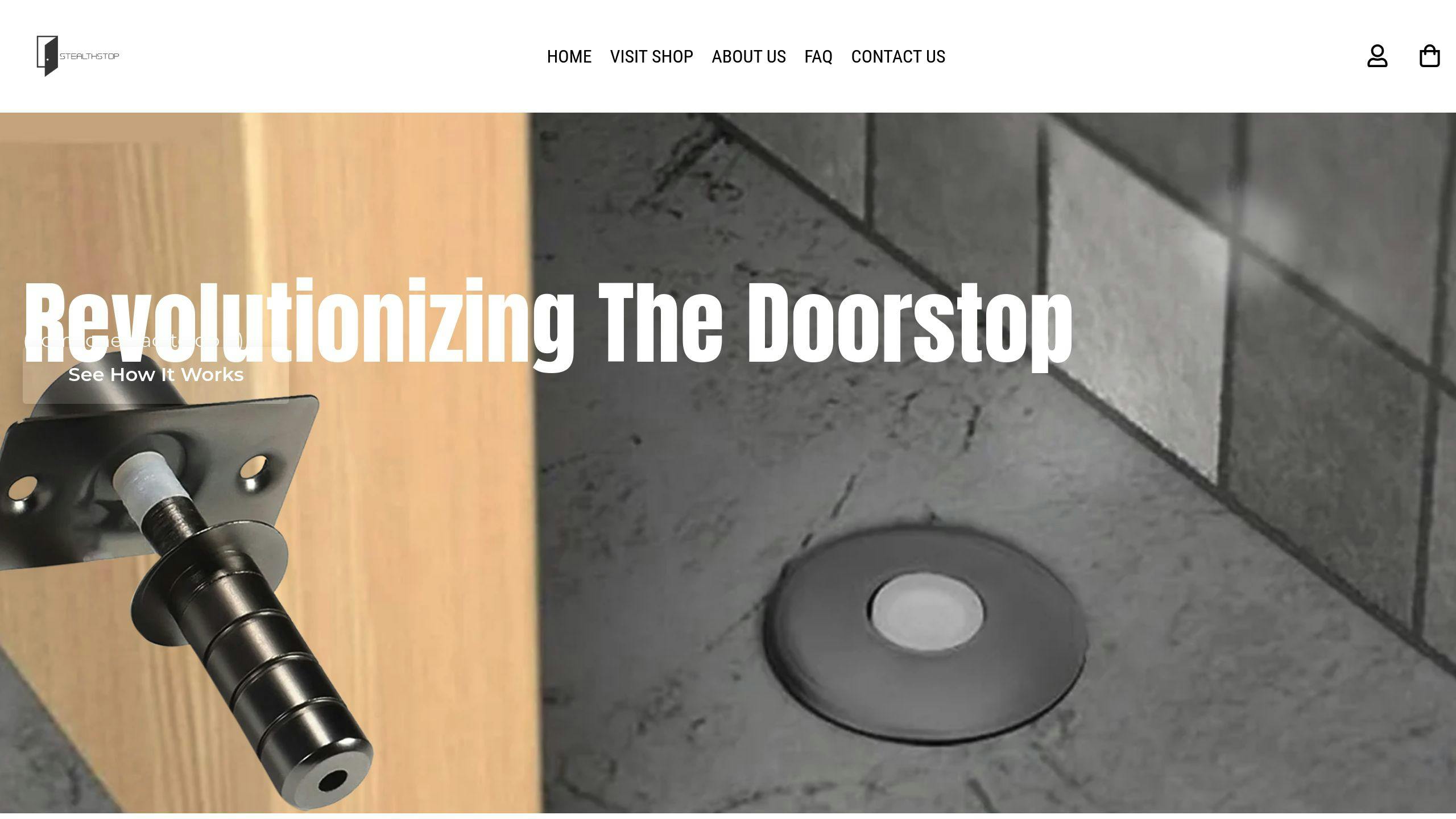
Magnetic door locks offer solid security, but products like StealthStop take door management to the next level, especially in smart home setups.
Features of StealthStop
The StealthStop Invisible Magnetic Door Stopper combines sleek design with reliable performance. It’s easy to install and integrates smoothly into smart home systems.
| Feature | Specification | Benefit |
|---|---|---|
| Design & Material | Durable, invisible stainless steel | Keeps a clean look while ensuring durability |
| Magnetic System | Neodymium Magnet | Delivers strong and dependable door control |
| Installation Time | 3 Minutes | Quick and hassle-free setup |
| Compatibility | 5-21MM Door-to-Floor Distance | Works with a variety of door setups |
The neodymium magnet ensures steady and reliable door control without compromising usability. Its waterproof and discreet design blends effortlessly into any space, maintaining both function and style.
StealthStop in Smart Home Setups
StealthStop proves to be an excellent addition to smart home environments. Its adaptability to different door types makes it a great match for existing smart door systems.
| Application | Integration Method | Smart Home Benefit |
|---|---|---|
| Door Control and Access | Magnetic Mechanism + Smart Controllers | Improves automation and ease of use |
| Security Enhancement | Works with Access Systems | Adds an extra layer of physical security |
The sturdy stainless steel construction is perfect for high-traffic areas and automated setups. Plus, its simple installation process ensures it can be added to your smart home without disrupting current automation systems.
Conclusion
Summary and Tips
Adding magnetic door locks to your smart home setup can improve both security and ease of use. The key to success lies in choosing compatible components, installing them correctly, and keeping up with maintenance.
Here are some quick tips to keep in mind:
| Aspect | Tip |
|---|---|
| Installation | Use the right tools for proper alignment. |
| Integration | Check that it works with your smart hub. |
| Maintenance | Perform monthly updates and inspections. |
A well-thought-out plan is crucial - select the right lock, ensure smooth integration, and focus on proper installation. Regular updates and inspections will keep your system running smoothly, while additional features like StealthStop can add both functionality and a modern touch.
Prioritize both security and convenience when setting up your system, and always choose hardware that works seamlessly with your current setup to avoid any issues.
